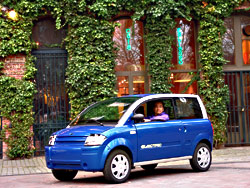The ZENN car is as silent and austere as its name suggests. As it pulls out of the MC Electric Vehicles dealership on South Dearborn Street, the crunching of the pavement overwhelms the barely audible, jetlike whine of the car’s engine.
The Mini Cooper–size two-seater heads into the International District, with MC Electric sales VP Steve Mayeda at the wheel. Mayeda turns off Jackson onto a steep side street and hits the brake, noting that he has come to a full stop. With all the suspense of a roller coaster climbing its track, the ZENN ascends the hill—topping out at 13 miles per hour.
But the Toronto-made ZENN isn’t built for speed: Its speedometer won’t display any number above 25, and after 40 miles, you need to plug it in for a recharge. The whole experience is a little underwhelming, especially if you’ve seen Chris Paine’s documentary Who Killed the Electric Car?, which was featured at last year’s Seattle International Film Festival and tells the story of General Motors’ EV1, a fully electric two-seater that didn’t use a drop of gasoline. The sedan-sized EV1 could fly past any SUV on the highway and could go more than 100 miles on a single overnight charge.
GM manufactured the EV1 in the late ’90s, and then pulled the plug on production after California dropped a proposed zero-emissions requirement under pressure from oil companies and automakers, including GM itself. Even worse for EV1 enthusiasts—who loved the car so much they staged a mock funeral for it—GM refused to renew drivers’ leases and rejected buy offers, destroying every last one of the cars in an attempt to wipe the EV1 from the collective memory. In reality, however, nobody killed the electric car—not completely, at least.
All along, cheerfully defiant tinkerers have been converting gas guzzlers to electrics and debuting new brands such as e-Ride, GEM, Might E Truck, Dynasty, and, since November, the ZENN.
“I think a lot of this is going to be groundswell from a lot of small businesses like us,” says Jim Johnson, proprietor of MC Electric, who also has a shop in Portland. “There’s a lot of geniuses doing this in their garages.”
Johnson, a former Caterpillar engineer who opened his Dearborn shop in 1978, started out selling golf-turf maintenance equipment and switched to electric mowers in the late ’90s. He began offering electric cars in 2003, and says he has sold about 100 since.
But we’re not talking about sporty, futuristic rides like the EV1: MC Electric, the only dealership of its kind in Seattle, specializes in Neighborhood Electric Vehicles, a class of vehicles that are legally prohibited by state law from going over 25 mph.
The NEV classification—which includes the ZENN—puts electrics on the road that are exempt from the stringent standards required for freeway-ready vehicles. For instance, NEVs don’t need air bags and don’t have to pass certain rollover tests. And since GM buried the EV1, smaller companies have developed technological innovations such as the lithium-ion battery, which is more powerful than the lead-acid batteries used in the EV1 and the ZENN. The problem is cost: Putting a lithium-ion battery in the ZENN could raise its price tag of $16,000 by $10,000.
One car that will utilize lithium-ion batteries while throwing cost to the wind is the Tesla Roadster, which is still in development. Highly anticipated by EV1 enthusiasts, the Roadster carries a price tag of $92,000, and contains an electric propulsion system that reportedly enables it to go from zero to 60 in four seconds. Furthermore, the Roadster will be able to travel 250 miles on a single charge.
The roadster clearly isn’t for everyone. But neither is the ZENN. Like other NEVs, the ZENN is programmed, by law, to max out at 25 mph—although savvy buyers can hack their way into the car’s computer system and rig it to go 45. And as far as the French-made body goes, anyone over 5-foot-8 is going to have to hunch down or stick their head out the window. The seat feels like you’re sitting on a life preserver, and the safety belt is frustratingly finicky when one tries to click it in.
For many urban apartment dwellers, charging the ZENN would be problematic: You can’t plug it in if you’re at the mercy of street parking. But even a condo dweller with underground parking would probably only have one spot, and if you only have one spot, do you really want to fill it with a car that can’t get on the freeway? Given that Metro buses work pretty wellh for in-city travel, one of the major selling points of having a car in Seattle is to get out of town. But you can’t do that with a ZENN, unless you want to spend hours on surface streets.
“Sometimes you just want to go 30,” Mayeda says. He acknowledges that the ZENN “isn’t for everyone.” That’s why Mayeda is working with state Rep. Mary Lou Dickerson to get a bill passed that would create a new class of electric vehicles that would be allowed to go 35 mph.
“People felt that at 25, [they’re] going to hold up traffic,” says Mayeda. “You actually felt safer going 30–35 than you do at 25.”
That might make EVs a bit more attractive, but the new class still won’t make the cars highway-legal.
Since November, MC Electric—one of only 16 ZENN dealers in the entire U.S.—has sold half a dozen ZENNs. Dave Barclift, Tumwater’s superintendent of public works, purchased a ZENN for the city’s meter-reading route. But they haven’t started using it because it’s not tuned up to the 40-mile range.
“Being the first ones to have received one in the state, we’re still working on a couple of things,” Barclift says.
Even Steve Lough, president of the Seattle Electric Vehicle Association, isn’t too charged up about the ZENN.
“I don’t think that [NEVs] are ever going to be a big part of the market,” he says. “Who’s going to use a car like that?”
Lough, a former car dealer who sold converted Renaults in the early ’80s and has advocated electric cars ever since, believes it’s up to the major manufacturers to drive the revolution forward. The large auto-makers have the experience to make quality vehicles and the capacity to mass produce them at reasonable prices, he says.
And it looks like that could happen. In January, GM debuted the Chevrolet Volt at the North American International Auto Show in Detroit. Still only a concept car, the hybrid Volt uses a battery pack that can be charged by a gas engine. But if you plug it in at night, and as long as you don’t drive farther than 40 miles, the car never uses gas.
So how come GM has suddenly gotten back into the electric-car game after shredding the last of its EV1s in 2005?
“The three factors are global warming, world oil supply, and what we’ve had to do militarily to hold onto oil—i.e., Iraq,” suggests Lough.
Johnson agrees, adding that publicity and education around energy issues have boosted electric-car interest.
“The government is saying we’ve got to get off our addiction to oil,” says Johnson.
And last Tuesday, Ford unveiled a modified Edge that combines hydrogen fuel cell technology and plug-in power. But it could cost millions to build. And GM’s electric hybrid isn’t expected to be production-worthy for at least another three years.
“The big three [GM, Ford, and Chrysler] are dragging their feet,” says Johnson. “They still have their tooling and want to maximize what they’re used to manufacturing— gas-powered engines. Plus, they’ve had a strong alliance with the oil companies [who] have invested a lot of money with the lobbyists and with the government and so on.”
Johnson points out that oil companies prefer hydrogen fuel cells—which are years away from viability—because they can tightly manage distribution. But they don’t have any control over electrical outlets. Hence, Johnson believes it could be almost a decade before GM and Ford start selling their electric cars.
In the meantime, smaller companies are attempting to re-create what was already there, trying to inject a little consciousness into America’s automotive addiction. “We tell people if you can walk, run, ride a bicycle, or bus, do that first,” says Johnson. “That makes the most sense. But that’s not happening.”








